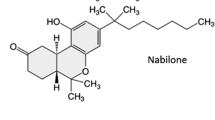Abstract
Introduction
The cannabinoids nabilone (Cesamet) and dronabinol (Marinol) are indicated for the management of chemotherapy-induced nausea and vomiting (CINV) in cancer patients who have failed to respond adequately to conventional antiemetic therapy.
Discussion
The endocannabinoid (CB) system interacts with numerous other systems and pharmaceutical cannabinoids target ubiquitous CB1 and CB2 receptors in the central nervous system and periphery, relieving nausea and vomiting and pain.
Summary
The benefits of this novel class of medications in cancer may extend beyond CINV, as indicated by data from preclinical studies and animal models.


Similar content being viewed by others
References
Abrahm JL (2005) A physician’s guide to pain and symptom management in cancer patients, 2nd edn. Johns Hopkins University Press, Baltimore, MD
Andrews PL, Naylor RJ, Joss RA (1998) Neuropharmacology of emesis and its relevance to anti-emetic therapy. Consensus and controversies. Support Care Cancer 6:197–203
Cichewicz DL (2004) Synergistic interactions between cannabinoid and opioid analgesics. Life Sci 74:1317–1324
Cloning the receptor (Autumn 2005) O’Shaughnessy’s Journal of the California Cannabis Medical Research Group. Available at: http://www.ccrmg.org
Dronabinol (Marinol®) (2005) Prescribing information. Solvay Pharmaceuticals, Marietta, GA
Green S, Newman Z, Nordquist S (2005) Pharmacological evidence for cannabinoid receptors in glutamatergic synapses at the crayfish neuromuscular junction. Pioneering Neuroscience 6:55–61
Hohmann AG, Briley EM, Herkenham M (1999) Pre- and postsynaptic distribution of cannabinoid and mu opioid receptors in rat spinal cord. Brain Res 822:17–25
Kalant H (2001) Medicinal use of cannabis: history and current status. Pain Res Manag 6:80–91
Khatcheressian J, Cassel JB, Lyckholm L, Coyne P, Hagenmueller A, Smith TJ (2005) Improving palliative and supportive care in cancer patients. Oncology (Williston Park) 19:1365–1376
Kris MG, Hesketh PJ, Somerfield MR et al (2006) American Society of Clinical Oncology Guideline for Antiemetics in Oncology: update 2006. Available at: http://www.asco.org
Lynch ME (2005) Preclinical science regarding cannabinoids as analgesics: an overview. Pain Res Manag 10(suppl A):7A–14A
Nabilone (Cesamet™) (2006) Prescribing information. Valeant Pharmaceuticals International, San Diego, CA
Nahas G, Harvey DJ, Sutin K et al (2002) A molecular basis of the therapeutic and psychoactive properties of cannabis (Δ9-tetrahydrocannabinol). Prog Neuropsychopharmacol Biol Psychiatry 26:721–730
Poli-Bigelli S, Rodrigues-Pereira J, Carides AD et al (2003) Addition of the neurokinin 1 receptor antagonist aprepitant to standard antiemetic therapy improves control of chemotherapy-induced nausea and vomiting. Results from a randomized, double-blind, placebo-controlled trial in Latin America. Cancer 97:3090–3098
Russo EB (2002) The role of cannabis and cannabinoids in pain management. In: Weiner RS (ed). Pain management: a practical guide for clinicians, 6th edn. CRC Press, Boca Raton, FL, pp 357–375
Roberts JD, Gennings C, Shih M (2006) Synergistic affective analgesic interaction between delta-9-tetrahydrocannabinol and morphine. Eur J Pharmacol 530:54–58
Sativex® oromucosal spray (2006). Available at: http://www.gwpharm.com/sativex.asp
Strangman NM, Walker JM (1999) Cannabinoid WIN 55,212-2 inhibits the activity-dependent facilitation of spinal nociceptive responses. J Neurophysiol 82:472–477
Svendsen KB, Jensen TS, Bach FW (2004) Does the cannabinoid dronabinol reduce central pain in multiple sclerosis? Randomised double blind placebo controlled crossover trial. BMJ 329:253
Tramer MR, Carroll D, Campbell FA, Reynolds DJ, Moore RA, McQuay HJ (2001) Cannabinoids for control of chemotherapy-induced nausea and vomiting: quantitative systematic review. BMJ 323:16–21
Walker JM, Hohmann AG, Martin WJ, Strangman NM, Huang SM, Tsou K (1999) The neurobiology of cannabinoid analgesia. Life Sci 65:665–673
Walsh D, Nelson KA, Mahmoud FA (2003) Established and potential therapeutic applications of cannabinoids in oncology. Support Care Cancer 11:137–143
Wiser W, Berger A (2005) Practical management of chemotherapy-induced nausea and vomiting. Oncology (Williston Park) 19:637–645
World Health Organization (April 3, 2003) Global cancer rates could increase by 50% to 15 million by 2020. Available at: http://www.who.int/mediacentre/news/releases/2003/pr27/en/index.html
Author information
Authors and Affiliations
Corresponding author
Additional information
A symposium, The Emerging Role of Cannabinoid Neuromodulators in Symptom Management, was held during the Multinational Association of Symptom Care in Cancer 18th International Symposium, June 23, 2006, in Toronto, Ontario, Canada. The following summarizes the presentations of the panel members.
Rights and permissions
About this article
Cite this article
Davis, M., Maida, V., Daeninck, P. et al. The emerging role of cannabinoid neuromodulators in symptom management. Support Care Cancer 15, 63–71 (2007). https://doi.org/10.1007/s00520-006-0180-0
Received:
Accepted:
Published:
Issue Date:
DOI: https://doi.org/10.1007/s00520-006-0180-0




